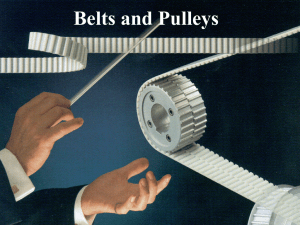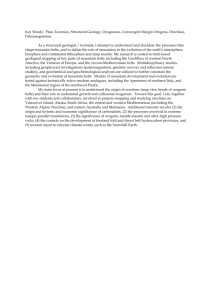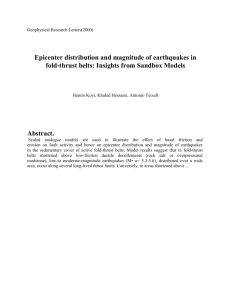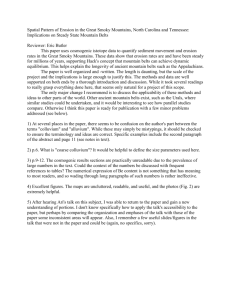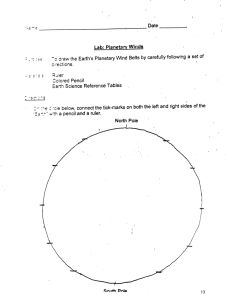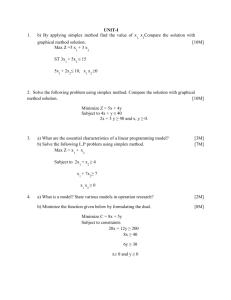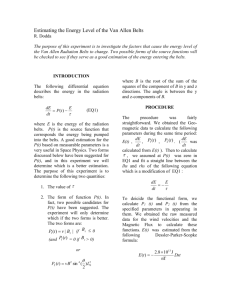backbelts - Michigan Municipal League
advertisement
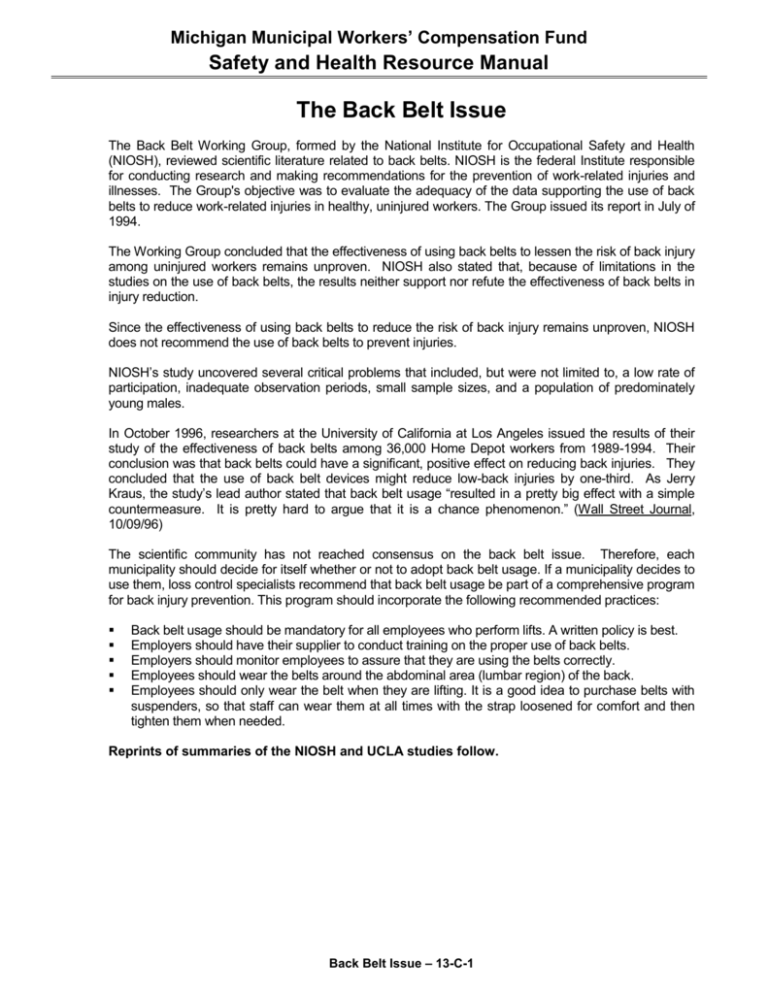
Michigan Municipal Workers’ Compensation Fund Safety and Health Resource Manual The Back Belt Issue The Back Belt Working Group, formed by the National Institute for Occupational Safety and Health (NIOSH), reviewed scientific literature related to back belts. NIOSH is the federal Institute responsible for conducting research and making recommendations for the prevention of work-related injuries and illnesses. The Group's objective was to evaluate the adequacy of the data supporting the use of back belts to reduce work-related injuries in healthy, uninjured workers. The Group issued its report in July of 1994. The Working Group concluded that the effectiveness of using back belts to lessen the risk of back injury among uninjured workers remains unproven. NIOSH also stated that, because of limitations in the studies on the use of back belts, the results neither support nor refute the effectiveness of back belts in injury reduction. Since the effectiveness of using back belts to reduce the risk of back injury remains unproven, NIOSH does not recommend the use of back belts to prevent injuries. NIOSH’s study uncovered several critical problems that included, but were not limited to, a low rate of participation, inadequate observation periods, small sample sizes, and a population of predominately young males. In October 1996, researchers at the University of California at Los Angeles issued the results of their study of the effectiveness of back belts among 36,000 Home Depot workers from 1989-1994. Their conclusion was that back belts could have a significant, positive effect on reducing back injuries. They concluded that the use of back belt devices might reduce low-back injuries by one-third. As Jerry Kraus, the study’s lead author stated that back belt usage “resulted in a pretty big effect with a simple countermeasure. It is pretty hard to argue that it is a chance phenomenon.” (Wall Street Journal, 10/09/96) The scientific community has not reached consensus on the back belt issue. Therefore, each municipality should decide for itself whether or not to adopt back belt usage. If a municipality decides to use them, loss control specialists recommend that back belt usage be part of a comprehensive program for back injury prevention. This program should incorporate the following recommended practices: Back belt usage should be mandatory for all employees who perform lifts. A written policy is best. Employers should have their supplier to conduct training on the proper use of back belts. Employers should monitor employees to assure that they are using the belts correctly. Employees should wear the belts around the abdominal area (lumbar region) of the back. Employees should only wear the belt when they are lifting. It is a good idea to purchase belts with suspenders, so that staff can wear them at all times with the strap loosened for comfort and then tighten them when needed. Reprints of summaries of the NIOSH and UCLA studies follow. Back Belt Issue – 13-C-1 Michigan Municipal Workers’ Compensation Fund Safety and Health Resource Manual BACK BELTS Do They Prevent Injury? The National Institute for Occupational Safety and Health (NIOSH) is part of the Centers for Disease Control and Prevention (CDC) within the Department of Health and Human Services. NIOSH is the federal Institute responsible for conducting research and making recommendations for the prevention of work-related injuries and illnesses. What Is the Purpose of This Pamphlet? Back injuries account for nearly 20% of all injuries and illnesses in the workplace and cost the nation an estimated 20 to 50 billion dollars per year. The National Institute for Occupational Safety and Health (NIOSH) believes that the most effective way to prevent back injury is to implement an ergonomics program that focuses on redesigning the work environment and work tasks to reduce the hazards of lifting. However, in response to the increasing human and economic costs of back injury, companies have implemented numerous other measures, either in conjunction with or in place of sound ergonomics programs. For instance, there has been a dramatic increase in the use of industrial back belts. The decision to wear a back belt is a personal choice; however, NIOSH believes that workers and employers should have the best available information to make that decision. This pamphlet outlines the current state of scientific knowledge on back belts and stresses the importance of an overall ergonomics program. Companies should not rely on back belts as a "cure all" for back injury, but should begin to undertake prevention measures which reduce the risks of lifting tasks. Do Back Belts Prevent Injury? In recent years, there has been a dramatic increase in the number of workers who rely on back belts to prevent injury during lifting. Back belts, also called "back supports" or "abdominal belts," are currently worn by workers in numerous industries, including grocery store clerks, airline baggage handlers, and warehouse workers. As their use has risen, NIOSH has increasingly been asked for advice on back belt selection. In response to these inquiries, the Institute decided to address a more fundamental question. Rather than ask "Which belt will best protect workers?" NIOSH researchers began with the question--"Do back belts protect workers?" Employers relying on back belts to prevent injury should be aware of the lack of scientific evidence supporting their use. A Lack of Scientific Support After a review of the scientific literature, NIOSH has concluded that, because of limitations of the studies that have analyzed workplace use of back belts, the results cannot be used to either support or refute the effectiveness of back belts in injury reduction. Although back belts are being bought and sold under the Back Belt Issue –13-C-2 Michigan Municipal Workers’ Compensation Fund Safety and Health Resource Manual premise that they reduce the risk of back injury, there is insufficient scientific evidence that they actually deliver what is promised. The Institute, therefore, does not recommend the use of back belts to prevent injuries among workers who have never been injured.* If you or your workers are wearing back belts as protective equipment against back injury, you should be aware of the lack of scientific evidence supporting their use. * Because the Institute's primary focus is on the prevention of injury, NIOSH did not address the use of back belts as medical treatment during rehabilitation from injury. Q A How Did NIOSH Come to These Conclusions About Back Belts? NIOSH systematically reviewed published peer-reviewed scientific literature on back belts to determine if they actually reduce the risk of back injury. Because there were few studies on the association between workplace use of back belts and injuries, NIOSH also reviewed studies of the relationship between back belt use and forces exerted on the spine during manual lifting. In other words, much of the existing research is based on theories of what causes back injury, rather than on the actual rates of workplace injury with and without back belt use. For a detailed technical report on the studies NIOSH reviewed, call 1-800-35NIOSH to request "Workplace Use of Back Belts: Review and Recommendations" (Publication No. 94-122). Q A What about the Claims That Back Belts... Reduce internal forces on the spine during forceful exertions of the back? Increase intra-abdominal pressure (IAP), which may counter the forces on the spine? Stiffen the spine, which may decrease forces on the spine? Restrict bending motions (range of motion)? Remind the wearer to lift properly? Have reduced injuries in certain workplaces? While all of these claims have been put forth as support for the use of back belts, they remain unproven. There is currently inadequate scientific evidence or theory to suggest that back belts can reduce the risk of injury. Moreover, even if back belts produced the biomechanical effects listed above, there is no proven link to injury prevention. NIOSH searched the peer-reviewed literature for studies investigating these claims and evaluated the scientific evidence they produced. A summary of the findings is provided on the following pages. Q I Heard that Back Belts... Reduce Forces on the Spine A Lifting may produce a variety of forces within the body which contribute to the pressure on the spine, termed "loading." Many of the studies NIOSH reviewed Back Belt Issue –13-C-3 Michigan Municipal Workers’ Compensation Fund Safety and Health Resource Manual sought to examine the impact of back belt use on loading. None of the studies provide sufficient data to indicate that industrial back belts significantly reduce loading during lifting. In fact, there is little evidence to suggest that these forces could be reduced with a back belt. Q A Q Increase Intra-Abdominal Pressure (IAP) While this theory remains controversial, some believe that if the pressure is increased within the abdomen, it will counterbalance the compressive force being exerted downward on the spine. The studies NIOSH reviewed were inconclusive, and the relationship between IAP and spinal compression is not well understood. Therefore, even if a back belt increased IAP, there is, as yet, no evidence that it would reduce forces on the spine or decrease back injury. Remind Workers to Lift Properly A At this point, there is little scientific evidence that back belts remind workers to avoid awkward postures and heavy loads. Q Numerous ligaments, tendons, and other soft tissues surround the spine and help hold it in place. The theory is that if back belts increase this support, they would decrease the motion allowed between segments of the spine, and therefore decrease damage to the discs in the lower back. There is no conclusive evidence that back belts increase the stiffness of the spine, and no proven relationship between this stiffness and the reduction of Stiffen injury. the Spine Reduce Bending Motions A Q A Q A Loading on the spine increases when a person has to bend as far forward as possible. If the ability to bend this far forward could be restricted by a back belt, the risk of injury would possibly be decreased. It would appear that abdominal belts help restrict the range of motion during side to side bending and twisting. However, they do not have the same effect when the worker bends forward, as in many industrial lifting situations. Reduce Injuries in Certain Workplaces There have been anecdotal case reports of injury reduction in workplaces using back belts. However, many companies which have instituted back belt programs have also implemented training and ergonomic awareness programs. The reported injury reduction may be related to these or other factors. On the basis of available evidence, the potential effectiveness of back belts in reducing the occurrence of low back injuries remains unproven. Why Is So Little Known About the Utility of Back Belts? Back belts were initially used in medical settings. These belts, termed "orthoses," resemble the corsets worn by women in the nineteenth century and are typically Back Belt Issue –13-C-4 Michigan Municipal Workers’ Compensation Fund Safety and Health Resource Manual used to provide additional back support during rehabilitation of injuries. Subsequently, athletes began using leather belts for weight-lifting. Back Belt Issue –13-C-5 Michigan Municipal Workers’ Compensation Fund Safety and Health Resource Manual Only in recent years has the "industrial back belt" been widely used. While there are more than 70 types of industrial back belts, the typical abdominal support used in workplaces today is a lightweight, elastic belt worn around the lower back, sometimes held in place with suspenders. Because of the recent emergence of back belt use in the workplace, there have been few published studies of the rate of injury among workers using the belts. These studies suffer from design flaws and have not produced sufficient support for or against the use of back belts. NIOSH encourages efforts to more adequately determine the association between back belt use and the prevention of low back injury and is committed to supporting further research in this area. Q A Could Wearing a Back Belt Increase the Potential for Injury? At this point, there are no definitive studies on either the beneficial or harmful effects of wearing back belts. Just as there is speculation that back belts may help, there is also concern that they may harm workers. As a result of the NIOSH review, the Institute is concerned with the potentially harmful effects associated with a false sense of security that may accompany back belt use. There is some research showing that workers believe they can lift more when wearing a back belt. If workers falsely believe they are protected, they may subject themselves to even greater risk by lifting more weight than they would have without a belt. Q A Q A How Should Workers Be Protected? Rather than relying solely on back belts, companies should begin to implement a comprehensive ergonomics program that strives to protect all workers. The most effective way to prevent back injury is to redesign the work environment and work tasks to reduce the hazards of lifting. Training in identifying lifting hazards and using safe lifting techniques and methods should improve program effectiveness. If you are putting all your prevention resources into back belts, you are not adequately protecting your workers. How Can an Ergonomics Program Be Implemented? A first step in implementing an ergonomics program would be to evaluate jobs that require frequent lifting; twisted or bent postures; or pushing or pulling. Redesign these tasks so that: The load is close to the body. The load is between shoulder and knuckle height. Twisted lifts are eliminated. Gravity moves the load when possible. Slides, chutes, hoists, and hand trucks are used to move heavy loads. Back Belt Issue –13- C-6 Michigan Municipal Workers’ Compensation Fund Safety and Health Resource Manual Weight is reduced to the lowest feasible level. For more information on how to implement an ergonomics program, call: 1-80035-NIOSH To obtain a copy of the NIOSH Lifting Equation, a useful tool for redesigning lifting tasks, call the National Technical Information Service at (703) 487-4650. Please reference order number PB94176930LJM. Q A What if I Still Decide to Use Back Belts? NIOSH believes that the decision to use back belts should be a voluntary decision by both employers and employees. Back belt use should not be a mandatory job requirement. If your workforce continues to wear back belts, you should remember the following points: There is a lack of scientific evidence that back belts work. Workers wearing back belts may attempt to lift more weight than they would have without a belt. A false sense of security may subject workers to greater risk of injury. Workers and employers should redesign the work environment and work tasks to reduce lifting hazards, rather than rely solely on back belts to prevent injury. The research needed to adequately assess back belt effectiveness will take several years to complete. In the interim, workers should not assume that back belts are protective. Q A Have Other Groups Questioned the Effectiveness of Back Belts? NIOSH is not alone in questioning the effectiveness of back belts. Other institutions issuing similar statements include the American Industrial Hygiene Association, the Bureau of Mines, the Army Office of the Surgeon General, the State of Washington Department of Labor and Industries, the Alberta Ministry of Occupational Health and Safety (Canada), the United Brotherhood of Carpenters, and the Construction Safety Association of Ontario. -----------------------------------------------------------------------This page was last updated : June 10, 1997 Go back to the NIOSH home page or to the CDC home page. --------------------------------------------------------------------- Back Belt Issue –13- C-7 Michigan Municipal Workers’ Compensation Fund Safety and Health Resource Manual Public Information Office NEWS ------------------------------------------------------------------------ LARGEST-EVER STUDY OF BACK SUPPORTS SHOWS THE DEVICES MAY REDUCE LOW-BACK INJURIES BY ONE-THIRD Workers who wear back supports can reduce the number of low-back injuries by about onethird, according to findings from the largest-ever study of the increasingly popular -- yet unproven -- devices. Researchers from the UCLA School of Public Health studied the workplace injury history of 36,000 workers of The Home Depot, a national home center chain, over a six-year period and found that low-back injuries fell by about one-third after the company imposed a consistent policy on back support use. The study, scheduled to be published in the November edition of the International Journal of Occupational and Environmental Health, is the largest study thus far to examine the effectiveness of back supports. No funding from manufacturers of back supports was used for the research. "We found compelling evidence that back supports can play an important role in helping to reduce back injuries among workers who do a lot of lifting," said Jess Kraus, an epidemiologist and director of the UCLA-based Southern California Injury Prevention Research Center. "Along with worker training and proper workplace ergonomic design, back supports can be part of an overall back injury prevention program." More than one million workers suffer back injuries each year, accounting for one out of every five workplace injuries and illnesses. Moreover, back injuries account for one-fourth of all workers compensation claims, costing businesses billions of dollars each year. Back supports have become standard issue for a variety of workers in the past several years, despite little scientific inquiry into whether the devices help prevent injuries. Several smaller studies have found uncertain results about the effectiveness of back supports. The National Institute of Occupational Safety and Health reviewed the scientific findings and issued a report in 1994 that concluded the benefit of the back supports remained unproven and did not recommend that they be used by uninjured workers. The UCLA researchers examined the effectiveness of back supports by analyzing worker injury data collected by the home improvement retailer Home Depot on 36,000 people who worked at its 77 California stores from the start of 1989 to the end of 1994. The company imposed a consistent back support use policy that was phased in between 1990 and 1992. Analyzing injury reports and other worker information, UCLA researchers found that Home Depot workers sustained about 31 back injuries per 1 million work hours without the supports, compared with about 20 injuries per 1 million work hours after a consistent back support use policy was imposed. Back Belt Issue –13- C-8 Michigan Municipal Workers’ Compensation Fund Safety and Health Resource Manual "I went into the study very skeptical about claims that these back supports could help reduce back injuries," Kraus said. "I suspected we would not find any positive effect, so I was very much surprised by our findings." The benefits of using the back supports were seen in men and women workers, in young and older workers, and among workers engaged in low and high levels of lifting, according to the UCLA researchers. The biggest benefit was seen among the groups of workers at highest risk of back injury -men who were 25 and younger or over age 55, had worked for the company for one to two years, and had jobs that required the highest intensity of lifting. Home Depot employees logged more than 100 million work hours during the study period. Other workplace training and safety measures adopted by Home Depot during the study period were taken into account by researchers. "People need to be careful about generalizing these findings to workers who are not engaged in material handling jobs," Kraus said. "There needs to be further research examining occupations such as construction, agriculture and mining to see if back supports prevent injuries to those workers." The Southern California Injury Prevention Research Center is one of 10 injury prevention research centers sponsored nationally by the U.S. Centers for Disease Control and Prevention. The center emphasizes study of injuries among high-risk groups, ethnic/racial minorities and other traditionally underserved populations. Funding for the back support study was provided by the Southern California Injury Prevention Research Center, the UCLA Center for Occupational and Environmental Health, the California State Department of Industrial Relations and the 3-E Company, a San Diegobased industrial safety consulting firm. Other authors of the study are Kathryn A. Brown, David L. McArthur, Corinne Peek-Asa and Lei Zhou, all of UCLA, and Lupe Samaniego and Chris Kraus of the 3-E Co. Back Belt Issue –13- C-9
